Outdoor’s digital transformation
Share
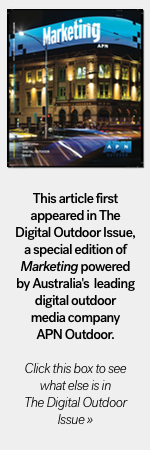 Advertising in the outdoor environment is finding new ways to connect and engage with the public through digital technology, with digital screens, beacon and image recognition technology, social integration and real-time dynamic creative just some of the exciting opportunities. Michelle Herbison looks at the state of digital outdoor and the medium’s future.
Advertising in the outdoor environment is finding new ways to connect and engage with the public through digital technology, with digital screens, beacon and image recognition technology, social integration and real-time dynamic creative just some of the exciting opportunities. Michelle Herbison looks at the state of digital outdoor and the medium’s future.
As digital technology transforms all aspects of marketing to become more relevant, personalised, data-driven and measurable, it is making a strong, positive impact on the outdoor advertising industry. While other traditional media struggle to adapt to the challenges of digital, outdoor is booming.
In October, the Outdoor Media Association (OMA) recorded its 10th month of year-on-year industry growth to $532.8 million in revenue so far, with digital outdoor making up 25.3% of total revenue, up from 16.5% for the same period last year.
Data from measurement body MOVE (Measurement of Outdoor Visibility and Exposure) shows outdoor audiences increasing 3.4% year-on-year as infrastructure improves and 12.2 million people move through outdoor environments daily.
The Commercial Economic Advisory Services of Australia determined that outdoor accounted for 5.2% of the $11.6 billion advertising spend in Australia in 2014 (excluding classifieds and directories), up from 4.8% in 2013.
PwC identified outdoor as a key growth channel in its 2015 Outlook.
Alongside this general industry growth, outdoor industry players have been investing in digital opportunities since 2008, when APN Outdoor established the country’s first roadside digital billboard above Melbourne’s iconic Young and Jackson hotel on Flinders Street.
The APN Outdoor portfolio of digital billboards, known as Elite Screens, has gone from strength to strength since then, with the company boasting 51 screens currently live in Australia and New Zealand and a further 14 due in Q1 2016.
Other outdoor players have been following suit, with selected bus shelters turning digital in October 2015 and other formats going down the programmatic route.
For just over a year, APN Outdoor’s XtrackTV has been engaging and entertaining rail commuters in Sydney and Melbourne with short-form video content with directional audio. Earlier this year XtrackTV successfully launched in Brisbane and, more recently, was switched on in Adelaide. The Perth portfolio, which will complete the national rollout, is anticipated for launch in early 2016.
While concerns about fraud in online advertising grow, the outdoor industry took a chance to highlight its authenticity and relevance to people in the real world.
The Outdoor Advertising Association of America (OAAA) launched a digital outdoor campaign in October, ‘Feel the Real’, which capitalises on this notion, aiming to build awareness of the medium’s abilities and encourage more media planners to incorporate outdoor into campaigns.
“We really look at outdoor as being a perfect complement to digital and that together both campaigns are stronger,” says Nancy Fletcher, CEO of the OAAA. With new technology comes new opportunities for brands to engage their audiences in fresh and creative ways – and many brave and adventurous early adopter brands have done just that – but the full potential of digital outdoor is yet to be seen.
Innovative opportunities in digital outdoor
Eye tracking, facial/gender/age recognition, beacon technology, location and geo-gating, dynamic content and social media integration are just some of the exciting innovations expected to increase in demand in the outdoor space as more marketers trial and prove their worth.
“The marketing opportunities for digital outdoor are staggering,” says Dave Petschack, managing director of marketing production agency One For All Productions. “The ability to deliver rapid content change that matches with consumer profiles has grabbed the attention of progressive thinkers.”
While outdoor has always had the ability to deliver messages where they are most relevant, digital adds the ability to deliver them when they’re most relevant, explains Grant Guesdon, general manager of MOVE, Australia’s national outdoor audience measurement system, endorsed by the OMA.
“Digital increases and strengthens what clients can do with outdoor, particularly offering immediacy and flexibility, including a short turnaround from planning/buying stages to messaging, the ability to hone the timing and/or location of the message,” explains Guesdon.
APN Outdoor general manager marketing Janine Wood sees the appetite for digital outdoor increasing in both Australia and New Zealand for those two main reasons: immediacy and flexibility.
Global outdoor specialist communications agency Posterscope conducted research in the UK last year that found relevant messaging delivers an up to 50% increase in memorability.
“Each screen delivers a different audience at diff erent times,” explains Joe Copley, managing director of Posterscope Australia. “Dwell times change, audience mood changes, intent changes and therefore the level of influence is different for each screen at any given moment in time. So digital outdoor offers the opportunity to share the right message or the right content at the right time with the right people, and that can deliver a huge uplift in engagement.”
Matt Sandwell, of research and brand strategy agency The Lab Strategy and Planning, emphasises the perceived authenticity of outdoor in the age of digital screens.
“Given the ever increasing amount of time in front of computers, TV screens and devices, outdoor in general is increasingly seen as a more real way to engage with media – not overly contrived, controlled, manufactured or manicured. It can remain dynamic and vibrant, but delivered at a more human pace.”
APN Outdoor’s research has shown how people’s mindsets differ when they’re commuting to work versus coming home, at the airport before security versus after security, travelling for business versus for pleasure and so on.
Mazda took advantage of these insights with its MX-5 campaign, which utilised digital billboards to serve different messaging depending on time of day. such as ‘You can be a few minutes late’ in the mornings and ‘It’s lunch. Open roads, not emails’ in the middle of the day.
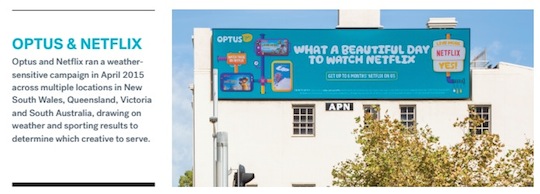
Optus and Netflix ran a weather-sensitive campaign in April this year across multiple locations in New South Wales, Queensland, Victoria and South Australia – drawing on weather and sporting results to determine which creative to serve.
While it’s easy to get excited about the possibilities, it’s important to stay strategic, says Wood.
“Our recommendation is always audience-focused, rather than asset- focused, and it really depends on what format has the greatest strengths for that particular advertiser or campaign.”
Investing in new ideas and untapped opportunities
APN Outdoor’s Wood is pragmatic about her company’s role in the adoption of digital outdoor, believing it is their responsibility to educate marketers its capabilities.
She is excited about the improved storytelling capabilities of digital billboards and signage compared with their static counterparts.
“However, there are a limited number of advertisers who are embracing that at this early stage – the adventurous early adopters,” she says.
One advertiser at the cutting edge of image recognition technology was Lexus, with its ‘This is the new Lexus’ campaign in January 2015.
The brand used digital billboards in five Australian cities that identified nine different brands, plus model and colour of passing vehicles and served a personal message to passing drivers such as, ‘Hey white Evoque, it’s never too late to cross over. This is the new Lexus’.
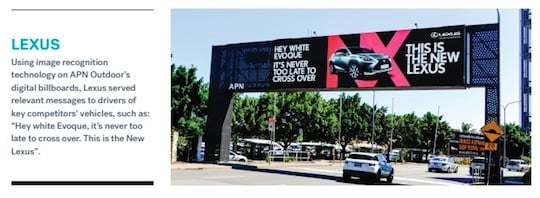
“I get excited when advertisers are becoming more revolutionary in regard to the way they’re actually briefing us these days – they want to do things with digital,” Wood says.
APN Outdoor is in a similar stage of educating consumers about digital opportunities with its new rail advertising format, XtrackTV, which Wood describes as “definitely ahead of its time”.
Effectively a series of televisions on train platforms, the medium gives advertisers the opportunity to engage with a captive audience when they’re waiting for their train, after going through the hustle of ticket machines and finding the correct platform.
“XtrackTV is probably the medium that I’ve been most excited about in my 35 years in the media industry,” she says.
Repeat advertisers come from a range of industries including automotive, entertainment, retail, real estate, FMCG, events and entertainment.
Luke Trigwell of Seven Network’s network marketing division says using XtrackTV to promote the new X Factor helped the show launch with 21% increase in ratings.
“XtrackTV formed part of our launch marketing allowing us to use music and video to create excitement in an environment where large numbers seek entertainment.”
Jerry Butterfield, channel manager at National Geographic Channel, has also had success using XtrackTV to promote series on National Geographic Channel.
“With campaigns for new TV series like Tales by Light, which is a series about the quality of the image that’s filmed and produced in 4K, all we’ve really tried to do is get across the magnificence of the show, and XtrackTV really helped us engage with a targeted audience and at scale,” he says.
Posterscope’s Copley believes many brands are not prioritising their efforts to review and update their approach to outdoor amid the growth in digital.
“There is so much change in communications generally and, while old habits die hard, not many of the accepted ‘truths’ of a few years ago remain unchallenged.
“For those truly focused on outdoor, the future of data-led, dynamic or real-time optimised messaging has already started.
“For others, it’s still in the ‘maybe, we’ll get to that later’ basket. As always, those who lead will be already be doing it better when the realisation reaches the masses.”
One For All Productions’ Petschack says digital takes outdoor beyond its already-powerful place in the marketing mix.
“Brand marketers need to consider outdoor as a digital channel with an outdoor audience. There is massive untapped opportunity for brands to extend their activity in other channels (social, digital, broadcast) to outdoor and to amplify their entire marcomm plan.” MOVE’s Guesdon says it all comes down to creative, creative, creative.
“Digital outdoor is often thought of as the fourth screen to TV, mobile and video. That doesn’t mean what works on those will work on outdoor,” he points out.
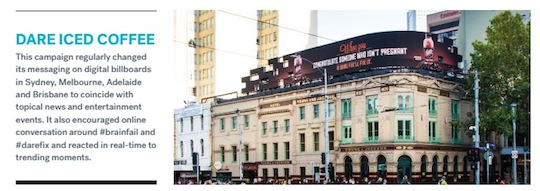
He likens the stage that digital outdoor is currently at to the early days of the web – people are still learning and starting to test different technologies.
“What is the best technology for your customers now? How will that evolve as technology, such as tap and scan, grows across mobile platforms; low tech today could be better than high tech. Just like the web, we probably haven’t seen the complete potential of digital outdoor yet.”
A great example of this was an Australian Meat and Livestock Corporation campaign that started off inviting people to SMS for more information.
This changed to a button that could be pressed to get a coupon or a recipe printed.
The low-tech button achieved 10 times more interaction from consumers than the high-tech SMS solution.
How programmatic will change the industry
Programmatic is a hot topic in marketing lately, and it is coming to digital outdoor.
Posterscope Australia is planning to start transacting at scale through automated systems in the next 12 months, says Copley, following its UK branch already doing so.
He says it’s “critically important” that the industry embraces automation and data-led media and creative thinking in order to deliver superior results for brands and customers.
“Automation and workflow efficiencies will create more thinking time – and data-exploration time. As the data becomes more robust and immediate, the scale of the real-time or right-time messaging opportunity will become more obvious – and automation will help ensure that quick decisions can be made with confidence – to deliver the most pertinent message to the most valuable audience,” Copley says.
Guesdon agrees that automating processes will make it quicker and easier to plan and buy outdoor campaigns – and advertisers and agencies will start to expect quicker turnaround times as the technology increases in prevalence.
The Lab Strategy and Planning’s Sandwell warns that the challenge with programmatic will be in ensuring speed and efficiency don’t come at the expense of quality decision-making.
“To be truly effective it will demand a deeper understanding of the context in which media is consumed, not just where, when and why, but understanding people’s mindsets and motivations during their moments and micro moments outdoors.”
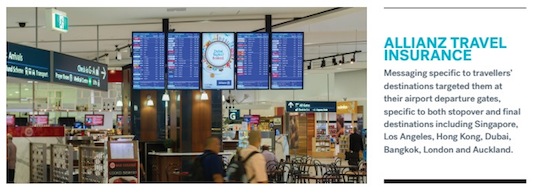
APN Outdoor’s Wood says automation definitely has a place in the future of digital outdoor, but believes it is people, and not machines, that will always be at the forefront of media planning and buying.
“We’ve got a long way to go before we’re actually trading assets in real-time without being conscious of where they’re going.”
She points out the approvals process that outdoor advertising must go through, including considerations of the Advertising Standards Board, the OMA and state legislations.
“Digital outdoor is the obvious choice as a format to be the most likely to be programmatically responsive first. But will it be happening in my lifetime? I doubt it very much,” Wood says.
The future of digital outdoor
Sandwell predicts a few key changes to the way people will spend time outdoors, and what this means for outdoor.
“People are wanting to pack more into their outdoor time, and wanting to be engaged by the environment around them,”
“[And] people are re-embracing their own local, communal space. This is seen via an increase in investment in civic spaces, and the rise of outdoor cinemas, night markets and food truck parks.
Petschack says outdoor has an opportunity to thrive while other media faces challenges.
“TV is becoming more fragmented, data-driven marketing can be soulless, social media marketing is resource heavy, press and magazines are re-finding their way and digital and mobile are proving to be part of the solution but no silver bullet,” he says.
“In this complex media environment one thing that brands can be sure of is that they look great in big, bold and colourful outdoor.
“Add to that new targeting, measurement and content technologies and the future is truly exciting.”
Wood hopes the future will see the standardisation of digital play-lengths across the country (currently each state has its own differing legislations).
Copley agrees this has been a barrier. “Roadside digital outdoor has been slower to develop [in Australia] than many developed markets, partly due to government restrictions,” he says.
Copley hopes Australia can take a leading position on the world stage, with our high level of exposure to digital (according to PQ Media), close to the highest smartphone penetration and the highest media spend per capita globally.
Wood believes outdoor is set to become an even larger part of advertisers’ marketing budgets in the future and, for some advertisers, even the centrepiece of their campaigns.
With outdoor being the ‘least avoided’ advertising medium, according to research conducted by APN Outdoor last year, Wood truly believes the paradigm is changing.
Despite the OMA reporting 10 months of consistent year-on-year industry growth, she says the growth is still “from a very low base”.
“It will be interesting as money starts to shift around if we become more of a lead medium rather than always a secondary, complementary medium.
“There are only a handful of advertisers in this country, more than five and fewer than 10, that would use outdoor as a centrepiece of their campaign.
“That means that we’ve got a great opportunity for growth.”















